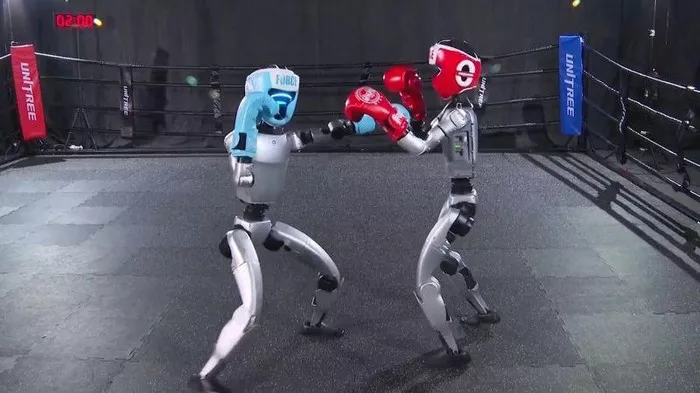We have officially entered the era of watching robots battle it out in the fighting ring.
In Hangzhou, Chinese robotics firm Unitree launched what is being called the world’s first humanoid robot fighting competition. The event, part of the World Robot Competition-Mecha Fighting Series, featured Unitree’s G1 humanoid robots battling under human control inside a ring.
The G1 robots stand just over 4 feet tall and weigh about 77 pounds. Equipped with gloves and headgear, they threw jabs, uppercuts, and surprisingly powerful kicks—all guided by human operators using remotes and voice commands. One match even ended in a knockout when a robot was unable to get up for over eight seconds.
The matches followed a standard kickboxing format with three rounds, judged on clean hits to the head and torso. Four robots competed, with the winner controlled by Chinese tech influencer Lu Xin. The event combined elements of “Real Steel” and “BattleBots” while showcasing China’s fast-growing robotics sector.
Though remote-controlled and somewhat choreographed, the competition’s goal goes beyond entertainment. Unitree’s marketing manager Chen Xiyun explained that these intense combat scenarios help improve the robots’ balance, movement, and durability. “Algorithms optimized for extreme conditions like combat could benefit daily life,” she said. Robots that can recover from hits might perform better carrying heavy loads or navigating stairs.
This competition is just the beginning. In December, Shenzhen will host the EngineAI Robot Free Combat Tournament, featuring full-size mechas with advanced movement, smarter decision-making, and larger-scale battles. These robots will mimic human motions, adapt quickly to changing conditions, and make rapid combat decisions.
EngineAI co-founder Yao Aiwen emphasized that the goal is to create more capable robots, not just tougher ones. The better these machines become at reacting and adjusting under pressure, the more useful they will be in factories, hospitals, and even homes.
Wang Peng, a researcher at the Beijing Academy of Social Sciences, summed it up: “This is precision robotics leaving the lab and stepping into the real world.”
Though early days, if robots throwing punches in a ring is where we stand now, what’s next could pack an even harder punch.
Related topics:

